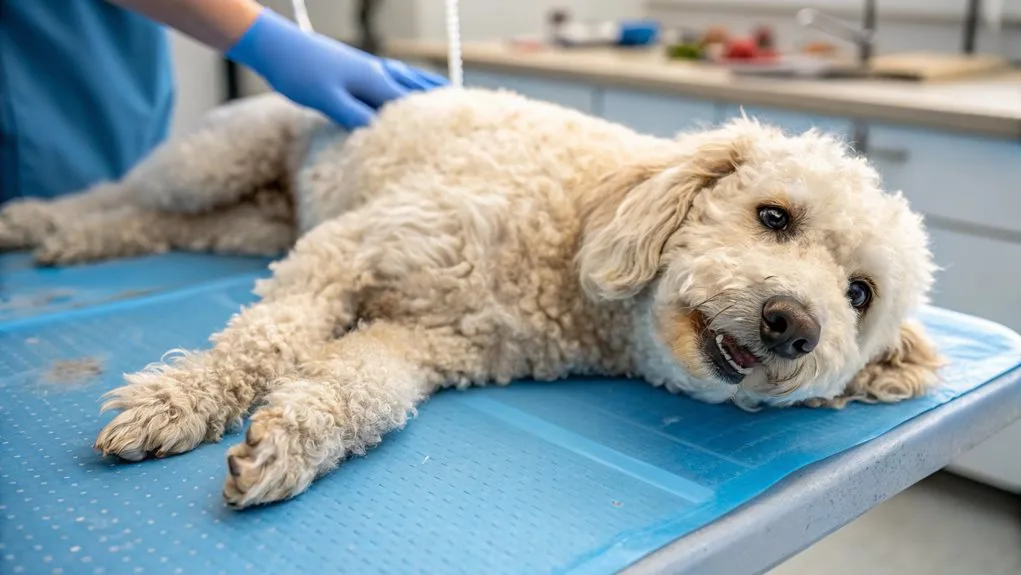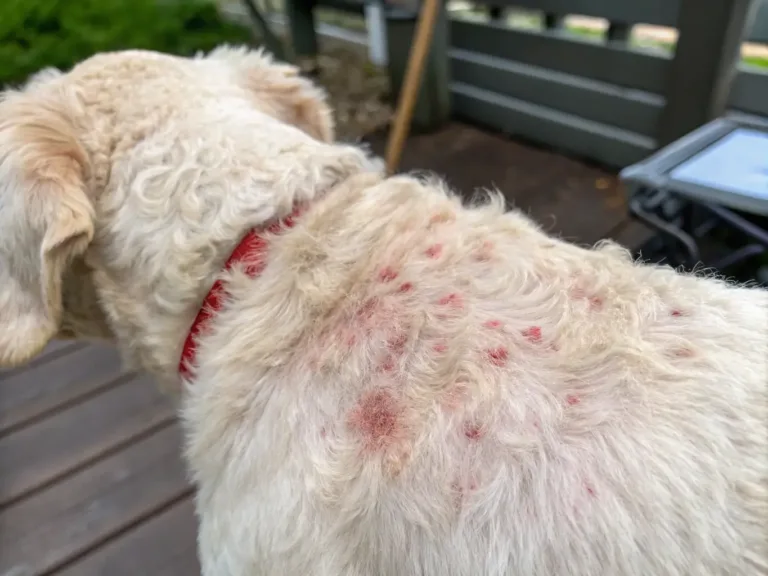Managing Tracheal Collapse in Toy Poodles

Managing tracheal collapse in Toy Poodles involves a multi-faceted approach to care and treatment. Key strategies include using harnesses instead of collars, maintaining a healthy weight, and avoiding triggers like excessive exercise or hot weather.
Regular vet check-ups help monitor the condition, while medications like cough suppressants and anti-inflammatories can provide relief. Environmental modifications, such as using air filters and maintaining proper humidity levels, substantially improve comfort.
A combination of gentle exercise, proper diet, and stress reduction helps minimize symptoms. Short walks and calm activities keep these precious pups active while protecting their airways. Understanding these essential care strategies opens the door to better management options.
Key Takeaways
- Use a harness instead of a collar to minimize pressure on the trachea during walks and daily activities.
- Maintain a healthy weight through proper diet and portion control to reduce strain on the respiratory system.
- Keep the environment free from irritants by using HEPA filters and maintaining optimal humidity between 40-50%.
- Limit exercise to short, gentle walks and avoid intense physical activity, especially during hot or humid weather.
- Administer prescribed medications like cough suppressants and bronchodilators while monitoring breathing patterns for signs of distress.
Understanding Tracheal Collapse

In toy poodles, tracheal collapse is a progressive respiratory condition characterized by the weakening and flattening of the cartilage rings that support the trachea, or windpipe. This condition occurs when these C-shaped rings lose their rigidity, causing the airway to narrow during breathing.
Genetic factors play a significant role in its development, with toy breeds being particularly susceptible. The unique anatomical differences in toy poodles, including their small size and delicate structure, make them more prone to this condition.
Think of the trachea like a flexible straw – when it’s strong, air flows freely, but when weakened, it can partially collapse during breathing or excitement. Regular grooming helps owners monitor their poodle’s breathing patterns and stress levels during maintenance sessions.
This explains why affected dogs often develop a characteristic “honking” cough, especially during exercise or when excited.
Understanding this condition helps owners recognize early warning signs. While it might sound scary, many dogs with tracheal collapse lead happy lives with proper management. The condition typically develops gradually, giving veterinarians and pet parents time to implement appropriate care strategies.
Regular monitoring and early intervention can make a significant difference in maintaining quality of life. With a hypoallergenic coat that requires minimal shedding maintenance, toy poodles can focus their energy on managing health conditions like tracheal collapse.
Common Signs and Symptoms
Three primary signs alert owners to potential tracheal collapse in toy poodles: a distinctive honking or goose-like cough, exercise intolerance, and respiratory distress.
Owner awareness plays a vital role in identifying these symptoms early. The characteristic honking cough often worsens during excitement, drinking water, or when pressure is applied to the collar area.
You might notice your poodle struggling to catch their breath after short walks or playtime – that’s exercise intolerance showing up. Some poodles may even develop a bluish tinge to their gums during episodes of breathing difficulty.
Due to breed predisposition, toy poodles commonly show additional symptoms like rapid breathing, especially in hot weather or stressful situations. They might stretch their neck out while breathing (a position we call “air hunger”) or become anxious when symptoms flare up.
These signs typically worsen over time if left unmanaged. While it might sound scary, remember that many poodles live happy lives with proper care. The key is catching these symptoms early and working with your vet to develop an effective management plan.
Diagnosis and Testing
Diagnosing tracheal collapse in toy poodles requires a systematic approach involving multiple diagnostic tools and procedures. Veterinarians typically begin with a physical examination, listening carefully to the dog’s breathing patterns and observing any characteristic “honking” cough.
They’ll also gather detailed information about the pet’s medical history and symptoms.
X-rays are usually the first diagnostic test performed, providing a clear view of the trachea’s structure. However, advanced imaging techniques, such as fluoroscopy and bronchoscopy, often prove more valuable as they can show the trachea in motion during breathing.
These dynamic tests help veterinarians determine the severity and exact location of the collapse.
Some clinics now offer genetic testing to identify potential hereditary factors that might contribute to tracheal collapse. While not a definitive diagnostic tool, these tests can help breeders make informed decisions and assist veterinarians in developing thorough treatment plans.
Blood tests and heart evaluations may also be recommended to rule out other conditions and guarantee the pup can safely undergo any necessary treatments.
The good news is that accurate diagnosis leads to more effective management strategies.
Since Toy Poodles typically live 14 to 18 years, early diagnosis and treatment of tracheal collapse can help ensure a long, comfortable life.
Regular monitoring is especially important since miniature breeds typically reach their full height by 6-7 months.
Medical Treatment Options
Medical management of tracheal collapse typically begins with conservative treatments aimed at reducing inflammation and minimizing respiratory distress. Veterinarians often prescribe cough suppressants, bronchodilators, and anti-inflammatory medications to help manage symptoms and improve breathing.
Weight management is also vital, as excess pounds can worsen the condition. Regular ear inspections help detect any additional respiratory complications early on.
For many Toy Poodles, palliative care becomes an essential part of the treatment plan. This includes lifestyle modifications such as using a harness instead of a collar, avoiding exposure to irritants like smoke or strong perfumes, and maintaining a calm environment to prevent excitement-induced coughing episodes.
Some dogs respond well to medications alone, while others may require more intensive care.
In cases where medical management isn’t providing adequate relief, surgical intervention might be recommended. However, before pursuing surgery, veterinarians typically explore all conservative treatment options.
They’ll work with pet parents to find the right combination of medications and lifestyle changes that best suits their Toy Poodle’s needs. Regular monitoring and adjusting treatments as needed helps guarantee the best possible quality of life for affected dogs.
Positive reinforcement training can help keep Toy Poodles calm during medical treatments and reduce stress-induced symptoms.
Environmental Management Strategies

Successful management of tracheal collapse requires careful attention to environmental factors that can trigger or worsen symptoms in Toy Poodles.
By creating an ideal living environment, pet owners can substantially reduce the frequency and severity of coughing episodes. Proper humidification helps keep airways moist and comfortable, while air purification systems remove irritants that could trigger breathing difficulties.
| Environmental Factor | Impact on Tracheal Health | Management Strategy |
|---|---|---|
| Air Quality | Affects breathing comfort | Use HEPA air filters |
| Temperature | Influences airway reactivity | Maintain 68-72°F |
| Humidity | Impacts airway moisture | Keep 40-50% humidity |
| Ventilation | Controls air circulation | Regular room airing |
| Allergens | Triggers coughing episodes | Remove dust/clean frequently |
Creating a clean, controlled environment helps minimize stress on your Toy Poodle’s respiratory system. Consider removing strong-smelling cleaners, air fresheners, and smoking from the home.
Regular cleaning of bedding and floors reduces dust exposure, while keeping windows closed during high-pollen days helps prevent irritation. With these environmental strategies in place, many Toy Poodles experience fewer symptoms and enjoy a better quality of life.
Regular brushing twice weekly is essential for Standard Poodles to maintain coat health and reduce dander in the environment. Using natural repellents like coconut oil or neem oil in your cleaning routine can help create a healthier living space for sensitive Toy Poodles.
Exercise and Diet Recommendations

Carefully planned exercise and dietary management play vital roles in supporting Toy Poodles with tracheal collapse. Short, gentle walks and calm leisure activities are ideal, as they help maintain fitness without putting excessive stress on the respiratory system.
It’s best to avoid intense exercise, especially during hot or humid weather when breathing difficulties can worsen.
For diet management, maintaining a healthy weight is essential since excess pounds can aggravate breathing problems. Feed smaller, more frequent meals to prevent pressure on the trachea from a full stomach.
Many veterinarians recommend elevated feeding bowls to help reduce strain while eating. Swimming can be an excellent low-impact exercise that strengthens joints while minimizing strain on bones and muscles.
Consider incorporating nutritional supplements like glucosamine and omega-3 fatty acids, which may help reduce inflammation and support overall respiratory health.
Watch for signs of fatigue during activities and adjust exercise intensity accordingly. Fun, low-impact games like gentle fetch or nose work can provide mental stimulation without overtaxing your pup’s breathing.
Unlike Standard Poodles that need vigorous daily exercise, Toy Poodles with tracheal collapse require gentler activity modifications to protect their respiratory health.
Conclusion
Tracheal collapse in toy poodles requires a thorough management approach combining medical intervention with lifestyle modifications. Through proper diagnosis, appropriate medication, and environmental adjustments, affected dogs can maintain good quality of life.
Regular veterinary monitoring, weight management, and careful exercise planning are essential components of successful long-term care. With dedicated attention to both medical and lifestyle factors, toy poodles with tracheal collapse can enjoy active, comfortable lives under proper management.






